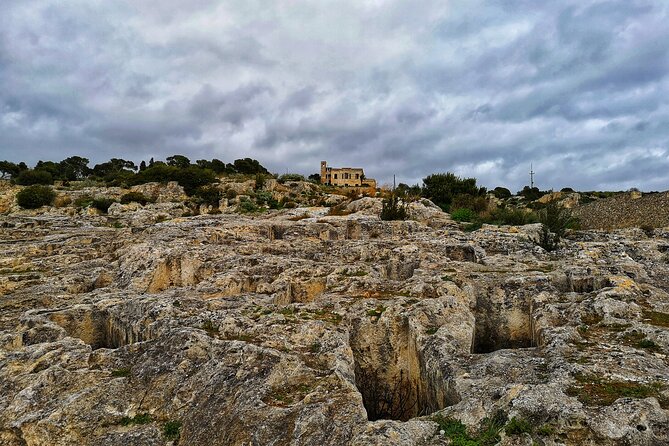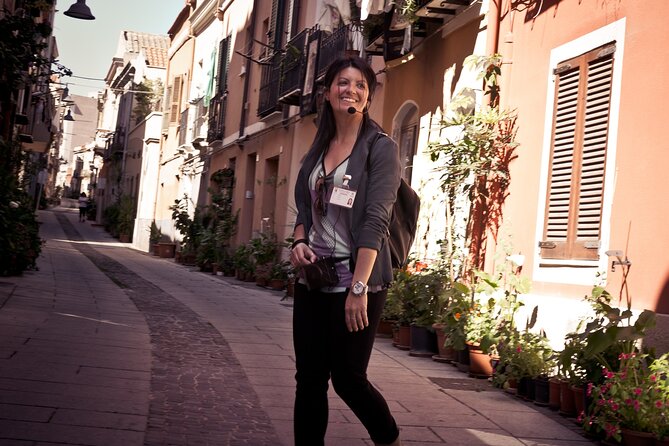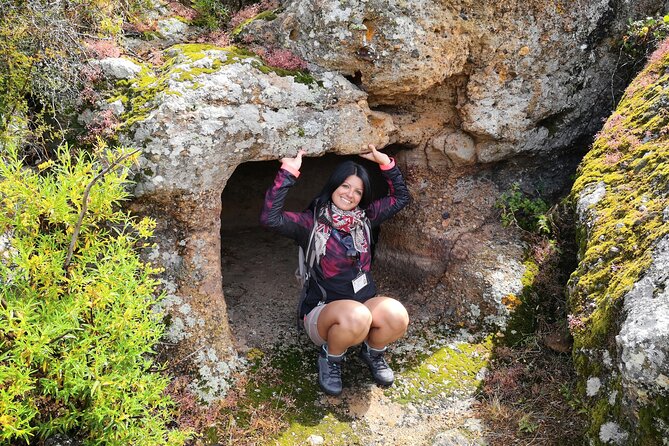Tuvixeddu Necropolis: the Cult of the Dead in Punic and Roman Times
Within the shadowy depths of the Tuvixeddu Necropolis lies a silent symphony of whispers from a bygone era. The remnants of ancient civilizations paint a cryptic portrait of the Cult of the Dead in Punic and Roman times. As the veil of history is gently lifted, an intricate tapestry of rituals and beliefs begins to unravel, offering a glimpse into a world where the boundaries between life and death blur into obscurity.
But what secrets lie buried within these sacred grounds, waiting to be unearthed by those curious enough to seek them out?
Key Points

- Evolution of burial practices reflects spiritual and social values in Punic and Roman cultures.
- Rituals and offerings honor the deceased, connecting with afterlife beliefs in Tuvixeddu Necropolis.
- Tomb architecture evolves from simple rock-cut chambers to elaborate Roman designs, blending cultural influences.
- Preservation efforts highlight the legacy of tomb architecture, involving collaborative projects for conservation and education.
Historical Background of Tuvixeddu Necropolis

Nestled in the heart of Sardinia, the Tuvixeddu Necropolis boasts a rich historical background that intertwines the cultures of the Punic and Roman eras. The site holds significant importance in understanding the cultural beliefs and funerary traditions of these ancient civilizations.
The Punic influence is evident in the unique burial practices that involved cremation and the deposition of ashes in urns. On the other hand, the Roman era brought about a shift towards inhumation, where bodies were buried intact.
This juxtaposition of cultural practices within the necropolis offers a fascinating insight into how beliefs surrounding death evolved over time. Visitors can explore the diverse burial methods and rituals that reflect the spiritual and social values of these ancient societies.
Significance of Cult Practices

The significance of cult practices at the Tuvixeddu Necropolis can be understood through the intricate burial rituals that symbolize the spiritual beliefs and societal values of the Punic and Roman civilizations. These practices shed light on the religious beliefs and afterlife traditions of the ancient people, offering a glimpse into their views on the spiritual realm and the journey beyond death. The cult practices also serve as a testament to the importance placed on honoring the deceased and ensuring their transition to the afterlife was conducted with reverence and care.
- Rituals reflecting spiritual beliefs
- Symbolism in burial practices
- Preservation of societal values
Archaeological Discoveries in the Necropolis
Archaeological expeditions in the Tuvixeddu Necropolis have unveiled a trove of discoveries that illuminate the ancient burial practices and cultural heritage of the Punic and Roman civilizations. Through meticulous archaeological excavations, researchers have unearthed a wealth of artifacts and tombs that provide valuable insights into the cultural influences that shaped burial customs in this ancient necropolis.
These excavations have revealed intricate burial chambers, funerary inscriptions, and grave goods, shedding light on the religious beliefs and social structures of the Punic and Roman societies. The discoveries made in the Tuvixeddu Necropolis not only enrich our understanding of the past but also highlight the significance of this site as a testament to the enduring legacy of the cult of the dead in ancient times.
Comparison of Punic and Roman Burial Customs
Unveiling the distinct burial customs of the Punic and Roman civilizations reveals fascinating insights into their unique practices and beliefs surrounding death and the afterlife. When comparing Punic and Roman burial customs, several key differences emerge:
- Treatment of the Deceased: Punic burials often included cremation, while Romans practiced inhumation.
- Grave Goods: Romans commonly buried their dead with elaborate grave goods, whereas the Punic tradition focused more on simplicity.
- Funerary Monuments: Romans erected grand mausoleums and monuments, contrasting with the Punic preference for underground chamber tombs.
These differences in Punic vs Roman burial customs highlight the diverse cultural traditions surrounding death and commemoration in these ancient civilizations.
Rituals and Offerings to the Deceased
In ancient Punic and Roman societies, honoring the deceased through intricate rituals and offerings was a deeply ingrained cultural practice. Offerings played a significant role in these ceremonies, symbolizing respect for the departed and beliefs in the afterlife.
The act of providing offerings such as food, drinks, incense, and personal belongings was a way to maintain a connection with the deceased and ensure their well-being in the next life. These rituals weren’t only a means of expressing grief but also a way to uphold traditions passed down through generations.
The symbolism behind the offerings reflected the community’s shared beliefs and values, creating a profound connection between the living and the dead through these sacred rituals.
Influence of Religion on Funerary Practices
Religion held significant sway over the funerary practices of ancient Punic and Roman societies, shaping the way in which rituals and offerings were conducted to honor the deceased. Cultural beliefs and spiritual traditions played a pivotal role in influencing these practices:
-
Ancestral Worship: Ancestor veneration was a common practice, where the deceased were revered and offerings made to ensure their well-being in the afterlife.
-
Gods and Deities: Beliefs in specific gods and goddesses influenced funeral rites, with ceremonies tailored to seek favor and protection from these divine beings.
-
Life After Death: The concept of an afterlife greatly impacted burial customs, leading to elaborate tombs and rituals aimed at ensuring a smooth transition for the departed soul.
Evolution of Tomb Architecture and Design
The evolution of tomb architecture and design in ancient Punic and Roman societies showcases a fascinating progression of cultural and artistic influences shaping burial practices.
In Punic times, tombs were often simple rock-cut chambers, reflecting a practical approach to burial. As Roman influence grew, tomb architecture became more elaborate, incorporating elements such as columns, frescoes, and intricate carvings.
The Romans also introduced the use of sarcophagi for burials, showcasing their advanced craftsmanship and reverence for the deceased. These architectural changes highlight the shift in cultural practices surrounding death and the afterlife.
The blending of Punic and Roman styles in tomb design provides insight into the evolving beliefs and traditions of these ancient civilizations.
Legacy and Preservation Efforts
The ongoing legacy of the evolving tomb architecture and design in ancient Punic and Roman societies has spurred dedicated preservation efforts to safeguard these cultural treasures for future generations. These preservation initiatives are crucial in maintaining the historical and cultural significance of the Tuvixeddu Necropolis.
Cutting-edge conservation techniques are being employed to protect the delicate structures and artifacts within the necropolis.
Collaborative projects involving archaeologists, historians, and local communities aim to ensure the long-term preservation of this ancient site.
Educational programs and guided tours are being developed to raise awareness about the importance of preserving the necropolis for its cultural value and historical insights.
Common questions
Are Visitors Allowed to Enter the Tuvixeddu Necropolis for Tours or Exploration?
Visitors can explore the necropolis, appreciating its historical significance. While regulations restrict certain areas, tours offer insight into the site’s cultural importance. The experience provides a profound connection to the past for those curious about ancient rituals.
How Long Has the Tuvixeddu Necropolis Been Open to the Public for Visits?
The history of the Tuvixeddu Necropolis has been open to public visits for decades, showcasing its preservation efforts, archaeological findings, and cultural impact. Excavation techniques have revealed valuable insights into the site’s significance.
Are There Any Specific Restrictions or Guidelines in Place for Visitors to Follow While at the Necropolis?
Visitor etiquette at the necropolis includes respecting the sacred nature of the site by maintaining silence and refraining from any disruptive behavior. Photography rules require visitors to obtain permission before taking any pictures within the necropolis premises.
Are There Any Famous or Notable Individuals Known to Have Been Buried at the Tuvixeddu Necropolis?
Famous burials at the Tuvixeddu Necropolis hold significant historical importance. Notable individuals interred here include prominent figures from Punic and Roman times. Their tombs provide valuable insights into the culture and practices of that era.
Is There Ongoing Research or Excavation Work Being Conducted at the Tuvixeddu Necropolis?
Excavation progress at the Tuvixeddu Necropolis reveals intriguing discoveries. Research findings shed light on ancient burial practices. Ongoing work uncovers mysteries of the past. Scholars explore the history of this site with great enthusiasm.
Last Words
To sum it up, the Tuvixeddu Necropolis offers a unique glimpse into the ancient Cult of the Dead during Punic and Roman times. Through its archaeological discoveries and rich history, the necropolis sheds light on the religious and funerary customs of past civilizations.
The rituals, offerings, and tomb designs reveal a deep reverence for the deceased and a belief in the afterlife. The legacy of the Tuvixeddu Necropolis continues to fascinate and educate us about the mysteries of the ancient world.